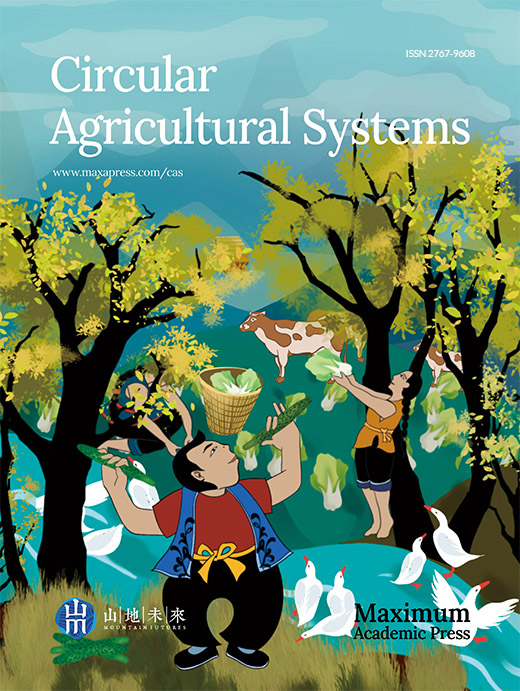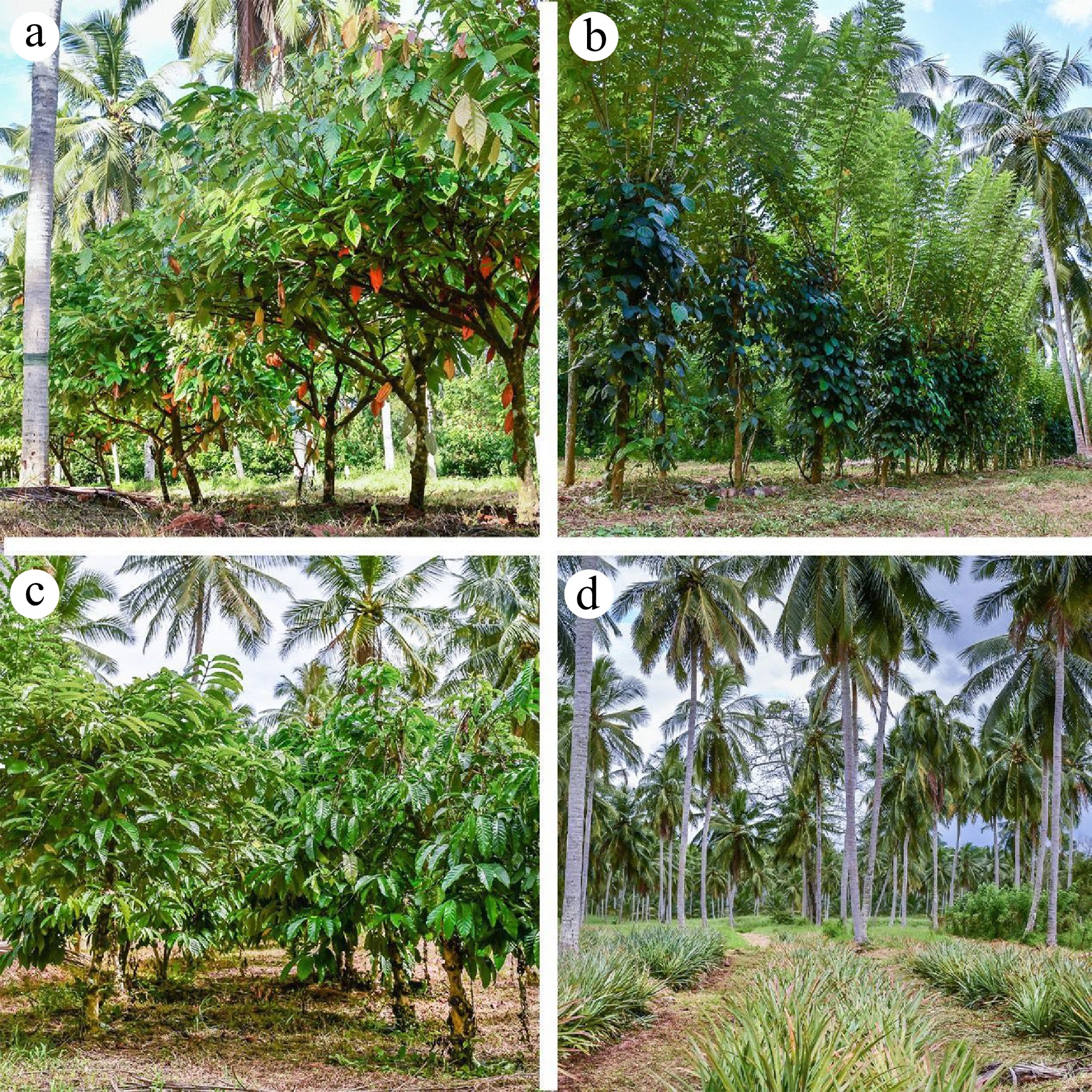-
Coconut is a globally important perennial crop known as the 'tree of life' in many communities worldwide[1]. It is widely cultivated and distributed in tropical and subtropical regions in the world[2], especially in 97 nations across the world's major continents, including Asia, Africa, and America[3]. According to the current statistics (Fig. 1), Indonesia, the Philippines, India, Sri Lanka, Thailand, and Malaysia together account for 80% of the world's coconut farming area, making them the world's biggest coconut producers[4]. Coconut crop enables the manufacturing of several products that can be used to maintain the national economy and plays an integral role in their cultures[5].
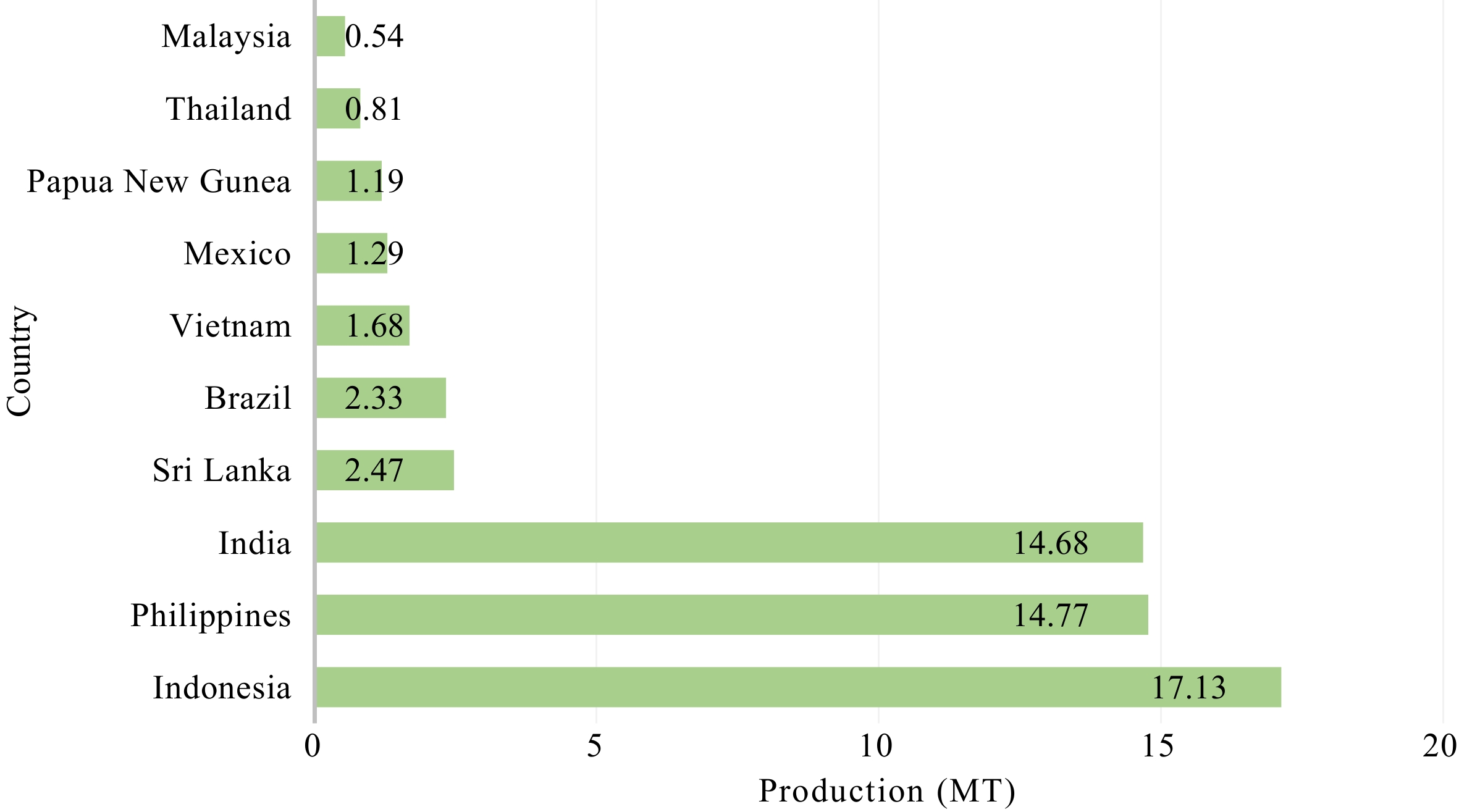
Figure 1.
Coconut production worldwide by leading countries[6].
Coconut is a rain-fed perennial with a significant economic impact in Sri Lanka. Three administrative districts, namely Kurunegala, Puttalam, and Gampaha, are the main coconut-growing areas, locally known as the 'coconut triangle'. This region has 57% of coconut plantations of the total coconut plantations of the country. It is a multifunctional crop that provides food, shelter, oil, medicines, fuels, building materials, and beverages in rural areas[7]. The annual nut production was 3,086 million nuts in 2020[8]. Most of the coconut cultivation systems in Sri Lanka exist as monocropping systems. In a monocropping system, resource loss is very high and productivity is low[9]. Another economic disadvantage of monocropping is that the investment in establishing the crop until its bearing age becomes significant, which a smallholder may not be able to afford the significant investment of crops until their bearing age. Due to the interaction between intercrop components and the different levels of competition for the utilization of environmental resources, intercropping has advantages over monocropping in terms of crop output[10]. If the intercrop components use environmental resources differently from one another, they complement one another's uses of those resources, making intercropping more efficient than monocropping and increasing yield[9]. Farmers can benefit agronomically from intercropping over monocropping[11]. Reduced risk from natural disasters, improved protection against pests and diseases, improved utilization of production elements, higher total agricultural yields per unit of land, and a fairer distribution of household labor throughout the agricultural cycle are just a few of these benefits. The objectives of the review are to show that intercropping in multiple cropping systems can be more beneficial than growing coconut as a monocrop, to point out its advantages and to select suitable crops at suitable times according to the morphology of the coconut tree. Furthermore, it is also an objective to identify the constraints of multiple cropping systems.
-
The intercropping system of coconut cultivation is usually adapted to maximize land use productivity. Coconut trees should be planted with a spacing of 8 m × 8 m[12]. Previous research found that the coconut monocropping system and its growth habits have used only 22.3% of the land area effectively, while canopy space utilization was around 30%, and solar radiation was around 45%[12]. The effective root zone of adult palms is found laterally within a radius of 1.8 m from the base of the coconut tree, and 95% of the roots are located 0−120 cm below the ground[13]. If the individual plants in the system have mutually exclusive root areas, the requirement for additional nutrients and water may not always be proportional to the cultivation intensity chosen. Different root activities in different plant mixtures allow for better utilization of natural and added nutrients while preventing nutrient loss due to exudation and migration[14]. Carbon stock in the Gliricidia-based mixed cropping system was significantly different compared to monocrop[15]. In coconut plantations, a wide range of crops are suitable for irrigation and rainwater conditions. Crops should be selected to maximize natural resource utilization while avoiding excessive competition with coconut[16]. The placement of the cropping system components are determined by the characteristics of the intercrops[17]. Intercrops are cultivated in the vacant space between coconut rows, according to the recommended cropping systems[18]. In various agro-ecological zones, a large number of compatible annual and perennial crops are produced alongside coconut. Fruit crops, vegetable crops, spice and beverages, tuber crops, cereals, and legumes crops occupy a special place among them[17]. Accordingly, Table 1 shows a list of various intercrops that can be grown with coconut in relation to each crop category. When growing intercrops in coconut plantations, the following factors need to be considered: age of the palms, availability of water, shade of the understory, soil characteristics, slope of the land, labor requirement, market demand, economic status of the grower, and social characteristics. One of the other key resources required for intercropping is labor. Labor requirements and the share of labor cost in the total cost of production can vary depending on the type and number of intercrops involved.
Table 1. Annuals and perennials grown as intercrops in Sri Lankan coconut plantations.[17]
Crop Common name Botanical name Fruit crops Pineapple Ananas comosus Banana Musa spp. Papaya Carica papaya Pomegranate Punica granatum Guava Psidium guajava Mango Mangifera indica Rambutan Nephelium lappaceum Durian Durio zibethinus Dragon fruit Hylocereus undatus Lemon Citrus limon Vegetable crops Chilies Capsicum frutescens Snake gourd Trichosanthes cucumerina Drumstick Moringa oleifera Brinjal Solanum melongena Bottle gourd Lagenaria siceraria Okra Abelmoschus esculentus Spice and beverage crops Pepper Piper nigrum Clove Syzygium aromaticum Cardamom Elettaria cardamomum Nutmeg Myristica fragrans Cinnamon Cinnamomum verum Cocoa Theobroma cacao
Tubers and root cropsCassava Manihot esculenta Sweet potato Ipomoea batatas Yam Dioscorea alata Taro Xanthosoma sagittifolium Ginger Zingiber officinale Turmeric Curcuma longa Cereals and millets Maize Zea mays Finger millet Eleusine coracana Foxtail millet Setaria italica Sorghum Sorghum bicolor Legume crops Groundnut Arachis hypogaea Soybean Glycine max Pigeon pea Cajanus cajan Cowpea Vigna unguiculata Green Gram Vigna radiata Gliricidia Gliricidia sepium If the annual rainfall is higher than 1,900 mm in the intermediate zone no considerable competition for soil moisture exists in coconuts and intercrops[17]. However, if artificial irrigation facilities are not available, it will be risky to produce coconuts and long-duration intercrops in the intermediate and dry zones[17]. Sun-loving plants can be grown under coconut cultivations less than 5 years of age as the distance between the canopies of two coconut palms is high during that period (Fig. 2a). Sun-loving plants also can be planted under the palms which are over 20 years of age (Fig. 2c). Crops that do not like sunlight can be grown for 5−20 years of age in coconut palms. During that period, there is a comparatively low distance between the two canopies of the palms (Fig. 2b).
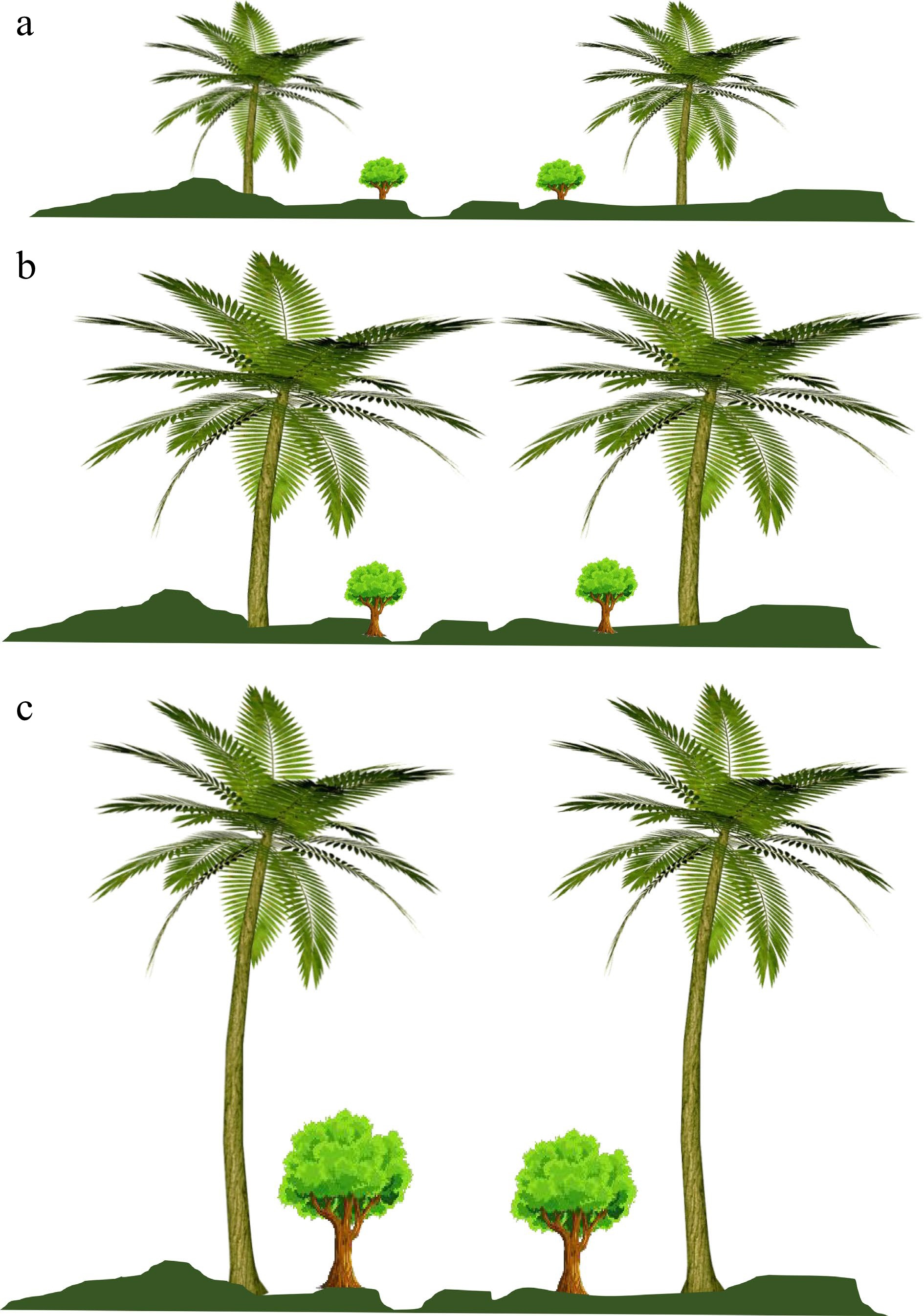
Figure 2.
Changing pattern of the canopy during the coconut palm lifespan. (a) Age less than 5 years, (b) age 5−20 years, and (c) age more than 20 years.
According to the age of the palm, intercrops can be divided into three groups (Table 2). As shown in Fig. 2a−c, the level of sunlight received by the tree and the preference of the intercrop for sunlight has been considered in making this classification. Figure 3a−d shows four different intercrops grown with coconut, which are maintained as demonstrations at the Makandura Sub-research Station by the Coconut Research Institute of Sri Lanka.
Table 2. Intercrop use as function of coconut crops growth stage[19].
Stage 1
(age 0−5 years)Stage 2
(age 5−20 years)Stage 3
(age more than 20 years)Pineapple Yam Cocoa Passion fruit Lemon Pepper Banana Chili Coffee Ginger Capsicum Vanilla Turmeric Ginger Avocado Cassava Turmeric Wild sunflower Guava Pasture Gliricidia -
Coconuts have a synergistic effect, resulting in higher coconut yield in multiple cropping systems[20]. The impact of intercropping on coconut yields has been studied as companion crops grow vigorously and deplete nutrients and soil moisture. Experiments revealed that the yields are not decreasing over time when management practices were appropriate for each crop[21]. Increased nut yields are achieved under the introduction of companion crops over five years[16]. Gliricidia sepium is grown as an intercrop in coconut lands which is a leguminous cover crop. This has a lot of potential for helping to improve poor soil conditions and land productivity. Gliricidia cropping methods based on coconut can be utilized to repair degraded coconut growing soils Tithonia diversifolia, sometimes known as wild sunflower or Mexican sunflower, is a flowering plant species. Because of the higher nutrient content and potential for use as green manure, some large-scale coconut growers in Sri Lanka prefer to plant them[22]. Wild sunflower has shown significant promise in improving soil fertility in nutrient-depleted soils[23]. Under coconut-based multiple cropping systems, the nutrient-rich soil conditions of the coconut plantation are conserved, and the yield of the coconut plantation is increased[17]. Furthermore, multiple systems earn extra income by cultivating other crops which has a monetary value; fruit crops, vegetables, tuber crops, cereals, and minor export crops. It also increases food security in the country. Considering coconut as a monocrop, the yield of all other mixed cropping systems is higher than the monocrop coconut yield (Table 3). Furthermore, the previous finding revealed positive interaction between perennial mixed crops and coconut yield[24].
Table 3. Effect of mixed cropping systems on coconut yield at Siri Kandura Estate, Dodanduwa (Wet zone) (1977−1989)[24].
Cropping system Mean nut yield (ha/year) % increase Coconut only 6,123 − Coconut + Cocoa 7,504 22 Coconut + Coffee 8,216 34 Coconut + Pepper 6,424 5 Coconut + Clove 7,191 17 Coconut + Cinnamon 7,623 26 Multiple cropping systems for improvement of soil properties
-
Intercropping improves soil fertility, water retention, and soil temperature, according to an earlier study[25]. Soil covering reduces the direct effects of rainfall, leading to soil erosion and land degradation. The use of Tithonia diversifolia as a mulch around the coconut palm enhanced nutrient levels in both the soil and the palm leaves. Tithonia diversifolia, when used as green manure, improves soil productivity by increasing soil organic matter content, soil moisture content, and microbial activity[22]. To continue the high soil fertility of coconut lands, the organic matter content, and other factors need to be improved[26, 27]. In both wet and dry zones in Sri Lanka, soil organic matter content, exchangeable potassium content, total nitrogen content, and phosphorus content revealed significant or substantially higher values where Gliricidia sepium was cultivated under coconut compared to coconut monocrop[27]. Increased nitrogen nutrition for coconut trees was seen in Gliricidia plots, most likely as a result of Gliricidia fixation of atmospheric nitrogen (Table 4). In addition to K, other plant nutrients including P, Ca, and Mg levels were also higher in soils containing Gliricidia, leading researchers to conclude that Gliricidia is mining nutrients from deeper layers of soils to the surface through the trimming and decomposition of leaves[28]. In coconut plantations, the presence of shrub vegetation reduces soil and water loss due to surface runoff. The proper land cover management system can improve freshwater infiltration and storage and the overall water system in the area[29]. Recently, there has been an increase in the interest in examining the soil water quality and soil health of intercrops under coconut lands[30]. Most of the benefits derived from intercropping cropping may be sufficient if the soil productivity and health quality are maintained over time. Growers in tropical countries have obtained, planted, selected, and domesticated plants because they are aware of the multiple benefits of the trees[31]. Competition for essential nutrients and soil water is expected to be high, particularly in an extremely intercropping system of agroforestry where completely different beneficial plant groups coexist[13]. Several approaches to maintaining soil moisture to increase coconut productivity are available in cultivation systems across the country, and intercropping is considered one. Even though coconut is a wide-spacing crop, it is challenging to grow crops in sandy soil under conventional conditions due to low water retention and soil fertility[32]. Cover crops are grown in coconut plantations with sandy soils in coastal areas as a soil and moisture conservation measure.
Table 4. Soil N, P, K, and Mg concentration under Coconut and Gliricidia based intercropping[19].
Crop category N (ppm)
0−30 cmP (ppm)
0−30 cmK%
0−30 cmMg%
0−30 cmCoconut only 4,903 3.4 0.15 0.8 Coconut + Gliricidia 6444 8.1 0.23 1.1 Multiple cropping systems for weed management
-
Unused space under the coconut palms can lead to the growth of perennial and annual weeds, which compete with coconut for soil moisture and plant nutrients. The cost of weed control, on the other hand, accounts for 20% of overall production costs, greatly reducing the profitability of coconut farming[33]. Coconut-based intercropping and mixed cultivation systems are effective and economically viable strategies for controlling weeds in coconut orchards as they occupy the unutilized space of the understory. Due to the heterogeneity of soil qualities, different cropping methods have a considerable impact on soil organism diversity and abundance[34]. In general, coconut intercropping with suitable crops reduces weed populations and increases coconut yields[35]. Weed density and their distribution are highly dependent on the age of plantations, agroecological zones, and farm size. Generally, the microclimate under the young coconut stands favors the rapid growth of noxious weed species over the mature plantation[36]. Also, weed competition appears to be more intense in dry zones than in wet zones[37]. Weeds in the coconut area can be controlled in various ways by mechanical, cultural, and mechanical technology[38]. But with an integrated combinatorial approach, some methods seem more efficient and economical in managing perennial weeds. According to the results of research conducted at the Pallama seed garden by the Coconut Research Institute, the yield variation was studied along with the weed control in coconut land (Table 5). Also, considering all the weed control methods and the yield variation in coconut cultivation, the coconut yield in the plantation with Gliricidia as an intercrop is higher than the one without weed control (Fig. 4). Controlling coconut weeds in Sri Lankan farms with a coconut-based cover crop cultivation system is an effective and economically viable strategy. Agroforestry systems and intercropping with appropriate crops can reduce weed populations while increasing overall coconut yields[39].
Table 5. Effect of different agronomic practices in controlling weeds on nut yield (nuts/palm/year) in Pallama Seed Garden, Sri Lanka[40].
Treatment Nut yield (nuts/palm/year) 2001 2002 2003 2004 2005 2006 Cover cropping 88 38 87 101 94 91 Planting Gliricidia sepium 77 38 74 84 59 79 Tractor slashing 78 27 81 87 75 76 Chemical weeding 81 44 97 102 99 93 Cattle grazing 83 36 75 81 66 75 Un-weeded 72 26 68 82 62 70 Significance ns ns * * * * LSD (P = 0.05) − − 15 13 17 14 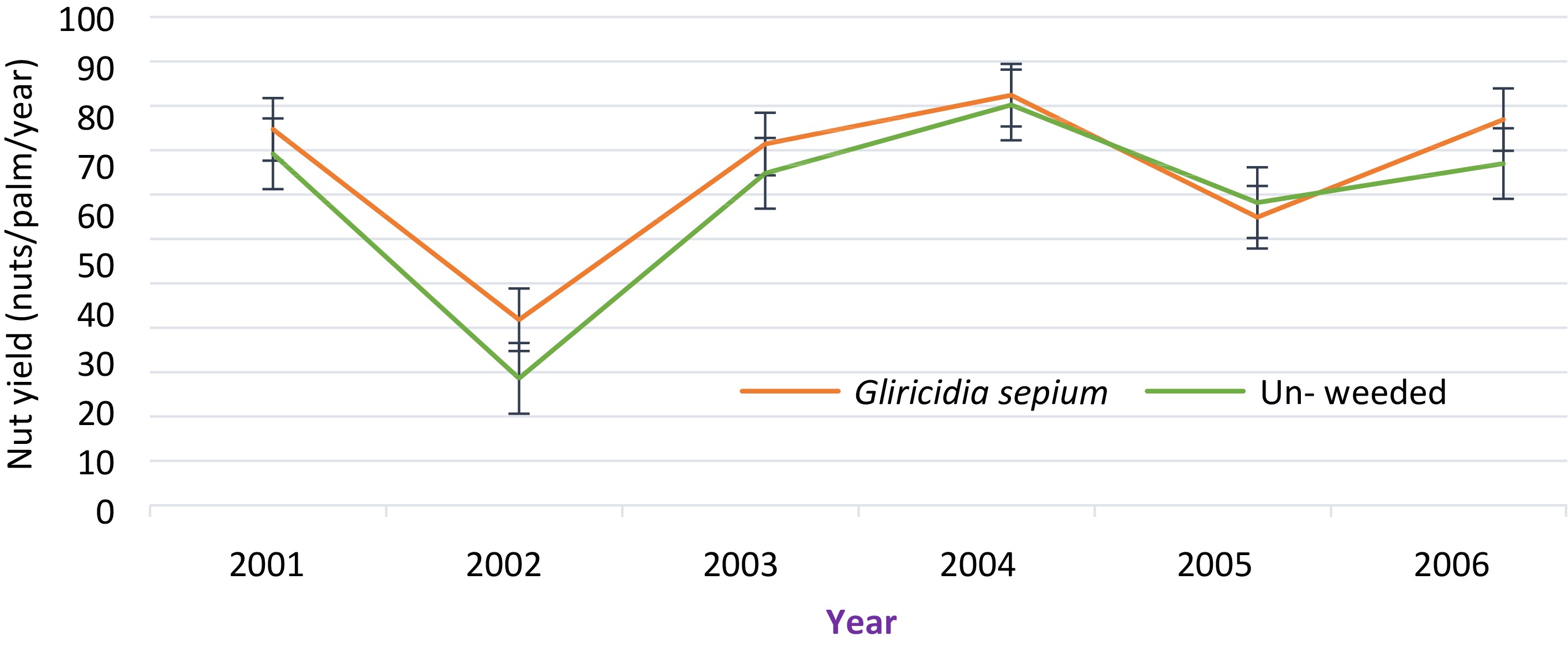
Figure 4.
Yield variation planting Gliricidia sepium as an intercrop for weed control[[40]].
Multiple cropping systems for socio-economic benefits
-
Intercropping systems are widely recognized in scientific and development communities as a method of maximizing land-use efficiency that could address significant global challenges to food security[41]. Helping rural populations can improve livelihoods in areas where agroforestry has a long history and indigenous knowledge[42]. The economic potential of various systematic intercropping models for farms was primarily limited to financial elements, particularly evaluating the potential net revenue to the farm family and the employment potential of various models[43]. The main benefits of intercropping under coconut cultivation include creating several additional food sources from coconut land, receiving additional income, and creating additional employment opportunities[44]. For their domestic activities, almost 90% of Sri Lanka's population consumes wood energy from Gliricidia sepium cultivated in home garden agroforestry systems[45]. Compared to single crop cropping systems, intercropping provides farmers with more economic advantages. These advantages lower the risk of natural disasters, improve pest and disease protection, increase land productivity per unit of land area and even incorporate into the farmer's life cycle[46]. An experiment carried out at the central plantation agricultural research institute in Kerala, India, revealed that the net return of the coconut as a monocrop remained poor even under rain-fed and irrigated circumstances (Table 6).
Table 6. Estimated income from various coconut-based farming systems (US
${\$} $ /ha/year)[47].Gross return (US${\$} $/ha/year) Net return (US${\$} $/ha/year) Under rainfed conditions Coconut as monocrop 1,369 319 With intercrop Cassava 2,153 694 Ginger 3,535 896 Under irrigated conditions Coconut as monocrop 2,988 1,450 Multi-storeyed cropping 4,108 1,895 Mixed farming 5,965 1,821 -
According to previous studies, agriculturalists have identified some major constraints that coconut growers face when engaging in intercropping activities due to unfavorable abiotic and biotic conditions. Soil degradation in coconut plantations is an extreme problem for coconut farmers. According to Liyanage et al.[17] the factors that influence farmers' decisions to abandon intercropping were adverse drought conditions, financial difficulties, price fluctuations, lack of technical knowledge, labor shortage, lack of good planting materials, and theft attacks. The nature and scope of these challenges are influenced by the area of the land and the type of intercrop used by each producer. Drought conditions, price instability, and thefts were described as pervasive challenges impacting all sizes of holdings, while smallholders confront large financial difficulties and trouble acquiring quality planting materials[48]. In addition to the aforementioned issues, the unorganized coconut supply chain, the vulnerability of coconut to world price fluctuations, and low farm productivity of some perishable fruits, roots, and tuber crops and vegetables are subjected to high postharvest losses have all been identified as issues related to intercropping under coconut[49]. However, pest and disease attacks and other pathogenic diseases are also identified as major problems related to intercropping[50]. Strong rules for developing intercropping practices for storing products, processing facilities at production sites, and transportation infrastructure to processing centers are also lacking.
-
Intercropping in coconut plantations is a traditional practice in small lands, but it is rare in large-scale systematic cultivation. Coconuts take up the most plantation space, but they yield the lowest net return per acre and give the fewest jobs. Therefore, different economically valuable crop species such as intercrops in coconut plantations must be popularized. Sunlight, land, water, and labor are the factors that are effectively utilized in a coconut-based intercropping system. This will improve land productivity, resource utilization, economic viability, and global food security. Also coconut plantation diversification enhances the biodiversity of the environment. Due to less efficient environmental and social issues associated with monocropping, shifting from monocrop to a mixed cropping system with more heterogeneous crops, is advantageous. Intercropping in coconut plantations requires extension and advising programs to optimize the utilization of land and other resources while producing additional money from coconut crops. Research and development programs are very important in determining the most suitable crop species and crop models for intercropping. To make the coconut-based crop system more productive and economically acceptable, research on biological and socio-economic elements and efficient consulting services are needed. Intercropping systems based on coconuts, on the other hand, can assist reach the United Nations Sustainable Development Goals (SDG) by 2030. Out of the 17 Sustainable Development Goals, coconut-based intercropping systems are primarily responsible for achieving SDG 1 (No Poverty), SDG 2 (Zero Hunger), and SDG 13 (Climate Action).
-
We would like to express our appreciation to the technical staff of the Agronomy Division of the Coconut Research Institute. We would like to express our deep gratitude to the editor and two anonymous reviewers for their valuable comments and critical evaluation.
-
The authors declare that they have no conflict of interest.
- Copyright: © 2022 by the author(s). Published by Maximum Academic Press, Fayetteville, GA. This article is an open access article distributed under Creative Commons Attribution License (CC BY 4.0), visithttps://creativecommons.org/licenses/by/4.0/.
-
About this article
Cite this article
Nuwarapaksha TD, Udumann SS, Dissanayaka DMNS, Dissanayake DKRPL, Atapattu AJ. 2022. Coconut based multiple cropping systems: An analytical review in Sri Lankan coconut cultivations. Circular Agricultural Systems 2:8 doi: 10.48130/CAS-2022-0008
Coconut based multiple cropping systems: An analytical review in Sri Lankan coconut cultivations
- Received: 18 May 2022
- Accepted: 06 November 2022
- Published online: 13 December 2022
Abstract: Coconut (Cocos nucifera L.) is a gift of nature and is cultivated worldwide because of its multiple uses. Based on the morphological characteristics of the coconut tree, when coconut is grown as a monocrop, land use efficiency is very low. According to previous findings, coconut monocropping planting systems and growth habits effectively used only 22% of the land area, while canopy space utilization was around 30%, and solar radiation was around 45%. Growing coconut along with a variety of other crops is a common practice in most coconut-growing regions to maximize land use efficiency. More than 100 different crops and systems have been identified that can be grown as intercrops with coconut cultivations. When growing intercrops in coconut plantations, the following factors need to be considered; the age of the coconut palms, water availability, shade of understory, soil characteristics, the slope of the land, labor availability, market demand, economic status of the grower, and social characteristics. This article discusses the significance and potential of intercropping and multiple-cropping systems appropriate for various coconut stands. The findings highlight an overview of profitable and sustainable intercrop species for coconut farming, as well as the benefits, constraints, and opportunities associated with various multiple-cropping systems. Finally, the study provides future research directions for the successful adaptation of coconut-based multiple cropping systems.
-
Key words:
- Coconut /
- Intercrop /
- Monocrop /
- Multiple cropping systems /
- Species


